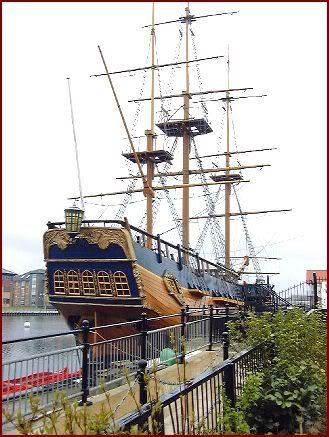Just past the Millenium Bridge we reach a replica vessel of Captain Cook’s ship, the Endeavour
HMB Endeavour was a small 18th century British sailing ship, famous for being the vessel commanded by Lt. (later Captain) James Cook, on his first voyage of discovery to the Pacific Ocean.His Majesty's Bark Endeavour was originally a merchant collier named Earl of Pembroke after Henry Herbert, 10th Earl of Pembroke.
Her construction was completed by early 1768 at Whitby, North Yorkshire. She was ship-rigged, and sturdily built with a capacious hold. Despite not being very fast, her flat-bottomed hull was well-suited to sailing in shallow waters and more important for her proposed use: she was, like other colliers of the north-east coast of England, designed to be beached. Her overall length was 32.3 m (keel 27.7 m), beam 8.9 m, and she weighed 400 tonnes (397 tons).
The voyage departed Plymouth on August 26, 1768, and took them to the Madeira Islands, along the west coast of Africa and across the Atlantic to South America, arriving in Rio de Janeiro on November 13, 1768.
The next leg rounded Cape Horn into the South Pacific and on to Tahiti, where she remained for the next three months while preparations were made for observing the transit of Venus.Her ostensible mission now completed, she continued with her "unannounced" tasks of charting the Southern Hemisphere. The Endeavour sailed from Tahiti to New Zealand, where she spent the next six months surveying and mapping the coast under constant harassment from the Māori population. From New Zealand she moved west to the coast of Australia, sighting land on April 19, 1770. On April 29, Cook and crew made their first landfall on the continent, at a place now known as Kurnell. At first Cook bestowed the name Stingaree (Stingray) Bay to the inlet after the many such creatures found there; this was later changed to Botanist Bay and finally Botany Bay after the unique specimens retrieved by the botanists Joseph Banks, Daniel Solander and Herman Spöring.

No comments:
Post a Comment